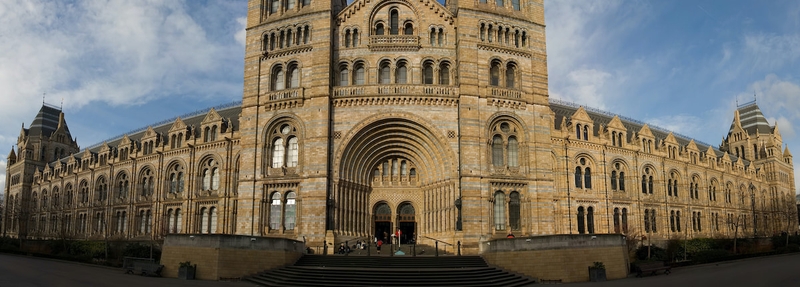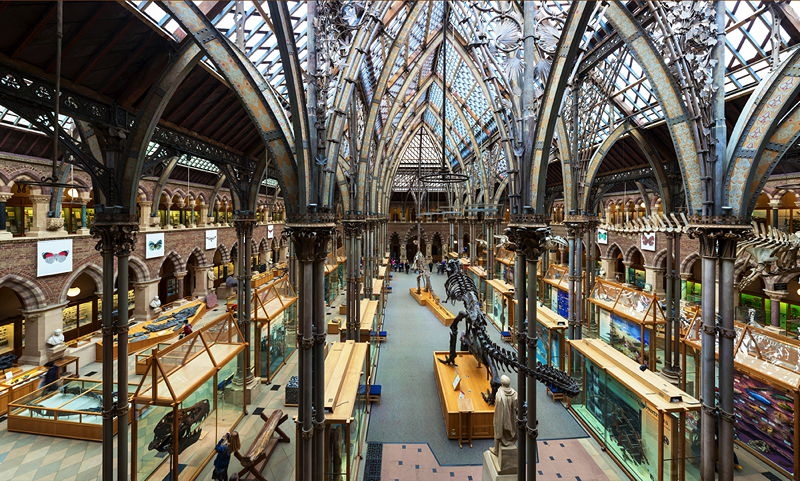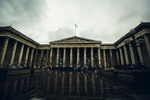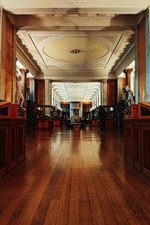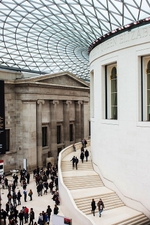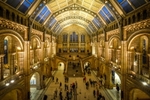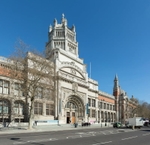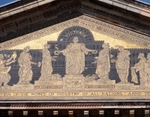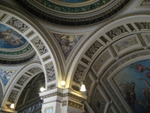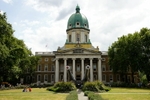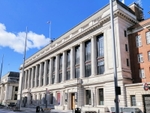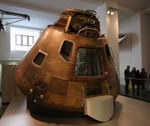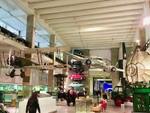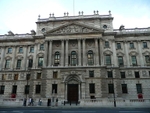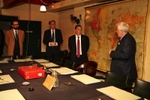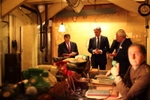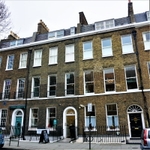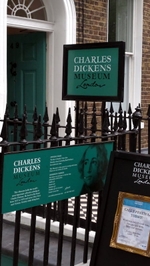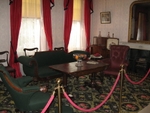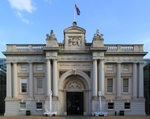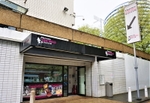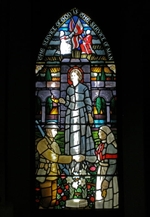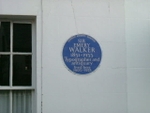1. The British Museum
The British Museum allows you to explore two million years of human history and the culture which has developed across this span of time. The museum takes you on a trip through the great cultures of the world and houses some of the most famous and significant historical pieces.
The museum has over 60 galleries to explore. Some of the must-see artefacts include the Rosetta Stone, the statue of Rameses II, the Portland Vase dated AD 5-25, the Sutton Hoo helmet and the intricate 12th century Lewis Chessmen. These are just the tip of the iceberg in a stunning collection of treasures from around the world.
A series of trails will take you on a tour of the museums most popular objects and can be a great way to introduce the kids to the British museum. You can also opt for one of the museum tours, such as the ‘Around the World in 60 Minutes’ tour, costing £14 per person. Special exhibitions run alongside the permanent collection, ensuring there is always something new to see.
Entry to this world famous museum’s permanent collections is free. The main entrance is found on Great Russell Street, a five minute walk from Tottenham Court road tube station. The museum has plenty of places where you can eat, including the Great Court restaurant which is found beneath the spectacular Great Court roof.
2. Natural History Museum
As soon as you walk in to Hintze Hall, the gateway to the museums galleries, and see the spectacular skeleton of the blue whale suspended above, you know this is a special museum.
Divided in to four zones, the Natural History museum takes you on an interactive tour of the natural world, right back to the time of the dinosaurs.
The blue zone contains the museum’s famous dinosaurs, a family favourite where the exhibits include the part skeleton of the fearsome Tyrannosaurus Rex. There are over 70 million specimens held by the museum, including its huge collection of mammals, reptiles, birds, fish, insects and assorted fossils.
The museum also features exhibits on the planet’s minerals and how they are formed. The volcano and earthquake section illustrates the forces of nature which are at work every day, with the earthquake simulator allowing you to feel what it was like during the powerful Kobe earthquake in 1995. Further treasures to look out for include the Winchcombe meteorite, the first fallen meteorite to have been recovered in the UK for 30 years.
There is so much to see at the Natural History museum in South Kensington. Entry is free and tickets can be booked online, where you can make a donation if you wish. There are a selection of cafes in the museum to recharge your batteries as you go around. There are also three shops within the museum from where you can buy your souvenirs and gifts.
3. Victoria & Albert Museum
Affectionately known as the V&A, this is the leading museum worldwide for art, design and all things creative. The museum celebrates 5,000 years of human creativity, with a collection in excess of 2.3 million pieces.
Art, textiles, fashion, architecture, photography and so much more from across the world is on display at the V&A.
The museum originated from the Great Exhibition in 1851, and the buildings and galleries are beautiful works of art and design in their own right. Among the periods and styles represented at the V&A are Art Nouveau, Gothic, Baroque, Rococo and Modernism. You can explore art and design from medieval times through to 1960’s fashion.
The timescale covered at the V&A is breath-taking. The Cast Courts feature copies of some of the most important artworks reproduced in plaster including Michaelangelo’s David and Trajan’s Column. The almost life-sized Tippoo’s Tiger from Southern India is another popular exhibit. Further must-see sections are the John Constable collection and the Raphael Cartoons.
The V&A is currently open Wednesday to Sunday, and admission is free. The museum is located on Cromwell Road, just a five minute walk from South Kensington tube station. There are two cafes in the museum, serving a selection of hot and cold food and drinks. The museum also has a main shop, a book shop, a fashion shop and the Exhibition Road Quarter shop.
4. Imperial War Museum
The Imperial War Museum tells the story of the people who served and lived through some of the most difficult periods in British history.
Founded during the horrors of World War One, this leading museum charts the wars and conflicts which have shaped our lives, while recalling the experience of those who experienced them at first hand.
The huge naval guns at the front form one of the most striking approaches to a museum you will see. The airplanes suspended in the atrium are further reminders of the power and scale of conflict. Here you can also see the imposing V2 rockets from the second world war. The Holocaust Exhibition is a poignant and chilling reminder of the suffering of this war.
The World War One galleries hold over 1,300 fascinating objects, including diaries, uniforms and weapons. You can walk through an immersive trench and look up at a famed Sopwith Camel plane. The Lord Ashcroft gallery recounts incredible stories of bravery and houses the world’s largest collection of Victoria Crosses.
Entrance to the galleries of this enthralling museum is free. Located on the Lambeth Road, a short walk from Lambeth North tube station, this museum gives voice to the ordinary people affected by war. The cafe serves freshly made food when you need a break to refresh, while the shops sell souvenirs, gifts, books, antique posters and more.
5. Science Museum
You do not not have to be a science aficionado to appreciate this museum in South Kensington, packed full of fascinating scientific and technological innovations.
The galleries of the Science Museum will show you just how we arrived where we are today, while telling you about the incredibly bright and resourceful people who paved the way.
Among the must-see items are the space suit worn by Helen Sharman on her mission at the Mir space station, a telescope made by William Herschel, the 1950 Pilot ACE computer and a Gypsy Moth flown by famed aviator Amy Johnson. There are also wonderful reproductions of Charles Babbage’s analytical engine and Crick and Watson’s DNA molecular model.
As well as the object galleries, the Science Museum has plenty of interactive opportunities which both educate and entertain. The IMAX cinema with its laser 4K projector shows films and live events on a giant screen using the latest immersive technology. The interactive WonderLab gallery lets you get hands on with science across its many different forms.
The Science museum is currently open from Wednesday to Sunday and entry to its galleries and many of the exhibitions is free. Some exhibitions may charge an admission price, including the WonderLab where day passes are from £9. There are cafes and picnic areas around the museum, while the shop stocks a range of gifts, science kits, books, toys and clothing.
6. Churchill War Rooms
This hidden gem is part of the Imperial War Museum group and offers a fascinating insight in to how the British war effort was run during the second world war.
These rooms beneath the streets of London were a hive of activity, a place where Winston Churchill and his war cabinet regularly met.
There is so much to see at this immersive museum. Visit the Cabinet Room where so many tough decisions were made, before heading to the Map Room where important information needed for the war effort was collated 24 hours a day. You can take a look at Churchill's private bedroom, where you can still see the map with circles marked on the locations where it was thought the Germans might invade.
Other areas to look out for include the transatlantic telephone room where Churchill would speak privately to the US President, as well as the BBC broadcast room, used to broadcast the speeches made from the underground bunker. The Churchill Museum forms part of the War Rooms museum and provides an insight in to the great man’s life, including personal objects such as his paintings and one of his iconic cigars.
The Churchill War Rooms are accessed by the Clive Steps on King Charles Street in Westminster. They are open Wednesday to Sunday, and adult ticket price starts from £22.50. An audio guide is included in the admission and provides insights in to the museum as you go around. The museum cafe offers a selection of sandwiches and drinks, plus a couple of lunch meal choices.
7. Charles Dickens Museum
In 1837 a largely unknown writer and journalist by the name of Charles Dickens moved in to 48 Doughty Street. When he left the property in 1839 Dickens was well on his way to becoming a household name, having published classics like Oliver Twist during this time.
Today, visitors have the opportunity to explore the home of this important literary figure.
Within 48 Doughty Street is the largest collection of Dickens memorabilia, personal items, letters and first editions, totalling around 100,000 pieces. You can visit the lovingly restored rooms such as Dickens’ library, study, dining room, drawing room, bedroom and kitchen. The house allows you to get a real flavour of life in a middle-class Victorian household.
There are some wonderful objects to see in the museum. The study contains the mahogany desk at which the famous author wrote some of his later works including Great Expectations. The drawing room has a plum-coloured leather armchair where Dickens sat, while the court suit Dickens wore to a royal reception can be seen in the Dressing Room. Letters and documents on display include the author’s will.
The museum is open Wednesday to Sunday with admission prices from £7.50. There are self-guided tour trails for families, plus audio guides aimed at the younger ones. The fittingly named Curiosity Shop is stocked with Dickens themed mementos and gifts.
8. National Maritime Museum
Greenwich has a long maritime tradition and so it only seems right that this is where the National Maritime Museum was founded in 1834. The museum holds the world’s largest maritime library and archive collection.
The wide-ranging collection of sea-faring crafts, historical artefacts, paintings and sculptures tells the story of Britain’s maritime past.
One of the prize artefacts is the jacket Nelson was wearing when fatally wounded at the Battle of Trafalgar. Take a closer look and you will see the bullet hole in the jacket. The museum’s collection of over 230 wooden sculptured ship figureheads is another popular exhibit. Another jewel in the museum’s collection is J.M.W Turner’s painting of the Battle of Trafalgar, his only royal commission.
You can explore all the various galleries, including Polar World, Pacific Encounters, Tudor and Stuart seafarers gallery and the Nelson, Navy, Nation gallery. The museum’s Caird library allows you to research your own family’s maritime ancestry through their huge collection of books and pamphlets.
There is much for the whole family to see and enjoy at this treasure trove of maritime history. Entry is free, with the museum open daily between 10am and 5pm. The museum has two cafes, with the Parkside cafe also having outdoor seating. The gift shop has a selection of souvenirs, books, prints, toys and games.
9. Florence Nightingale Museum
The Florence Nightingale Museum celebrates the life of ‘the lady with the lamp’, the founder of modern nursing. Florence Nightingale is an iconic figure in British history and the museum guides you through her life, including her work during the Crimean War.
Among the 3,000 artefacts held by the museum is one of the original lamps used during the Crimean War by this nursing trailblazer. The collection also holds a uniform from Florence Nightingale’s training school as well as one of her iconic black dresses.
The family trail is a great way to look around the three separate areas that make up the museum. The museum also stages events and exhibitions where you get to see even more artefacts from the extraordinary life of Florence Nightingale.
The museum is located on the grounds of St. Thomas hospital, close to the junction of Westminster Bridge road and Lambeth Palace road. Currently open every first full weekend of the month up to October, admission costs from £7 for adult concessions. There is a family ticket available for £20, which will admit up to two adults and four children.
10. Emery Walker’s House
This is another of London’s hidden gems, one of the finest examples of the arts and craft interior style. Emery Walker was an eminent Victorian typographer and a friend of William Morris, a hugely important figure in late 19th century design.
Walker’s home at 7 Hammersmith Terrace remains virtually unchanged from the time he lived there.
Hammersmith Terrace was a hotspot for the arts and crafts movement. Number 7 is a grade II listed townhouse, one of the few houses anywhere in the world to contain original Morris & Co wallpaper in the rooms. As well as this wallpaper dating back to the 1920’s, much of the house is furnished with William Morris & Co textiles.
Yet there are also other influences. Amid designs by Philip Webb, often called the father of the arts and craft movement, there is furniture from previous centuries such as the 17th century chair in the dining room, as well as rugs from the Middle East and Chinese ceramics. All the rooms are elegant and filled with fascinating objects. Step outside and you find yourself in a lovely walled garden which leads down to the Thames.
There are lots of little delights throughout the house, garden and conservatory. Visits are booked as part of a ninety minute guided tour, with general admission priced at £15. You will be accompanied by an experienced tour guide who will help you get the most from your visit. Guided tours run on Thursdays and Saturdays until the end of November, although the narrow stairs between floors and the steps to the garden are not wheelchair accessible.
